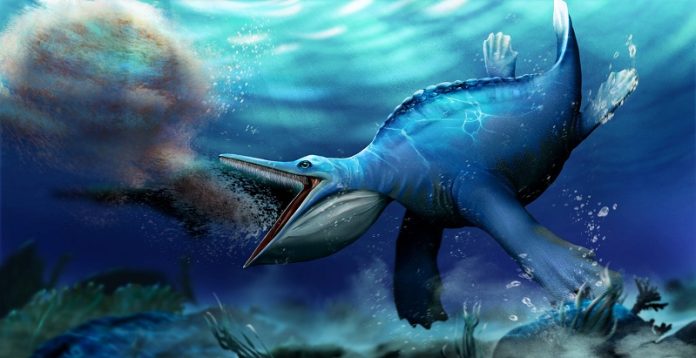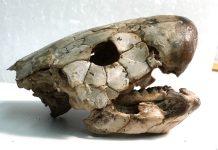
Imagine a dinosaur-like creature swimming around, opening its giant mouth, and swallowing up loads of tiny shrimp in one go.
That might sound like a scene from a movie, but researchers have found proof that such creatures really existed!
In China, a team of scientists from both China and the UK discovered an extraordinary fossil of an ancient sea reptile named Hupehsuchus.
From the looks of it, this reptile used a similar technique to today’s whales to feed on its prey.
Just like whales gulp down tons of water and then use special filters to trap tiny creatures for food, this reptile seemed to do something very similar.
The scientists examined the Hupehsuchus’s skull and found clues. The skull had special grooves and notches that looked a lot like the ones found in baleen whales.
Baleen whales, like the giant blue whale, don’t have teeth. Instead, they have what we call ‘baleen’ – long, thin strips made up of the same stuff as our hair and nails. They use this baleen to filter and catch their food. Hupehsuchus, it seems, had its own version of this baleen.
Zichen Fang, one of the lead researchers, expressed his amazement at this discovery. He mentioned that while we knew about this group of reptiles for around 50 years, we never really knew how they lived and fed. The fascinating part? This reptile existed around 250 million years ago!
Another scientist, Professor Michael Benton, shared how these reptiles existed at a crucial time on Earth. Just three million years before them, a big disaster (the end-Permian mass extinction) had occurred, wiping out a significant chunk of life. But nature bounced back quickly, and these large sea reptiles became an essential part of the marine world. It’s like nature’s version of a comeback story!
Now, here’s where it gets even more interesting. The research team didn’t just find one, but two skulls of Hupehsuchus.
Professor Long Cheng, who headed the research, shared how these skulls were even more detailed than previous finds. These skulls showed that this reptile had a unique long nose made up of separate, thin bones.
This structure was so special because, just like the baleen whales of today, it allowed them to open up their mouths wide and scoop up massive amounts of water (and the tiny creatures within) as they swam.
Li Tian, another scientist on the team, pointed out another fascinating fact. Just like modern baleen whales don’t have teeth (unlike their cousins, the dolphins, and orcas), Hupehsuchus too seemed to lack them. Instead, it likely had its own kind of filter system, possibly its own type of baleen.
In short, even though millions of years separate them, this ancient reptile and today’s whales might have more in common than we think!
For those who want to dive deeper into this research, the full details are available in the journal called Ecology and Evolution.
But for now, let’s marvel at the wonders of nature and how some things, like the art of filter feeding, remain timeless!
Follow us on Twitter for more articles about this topic.



